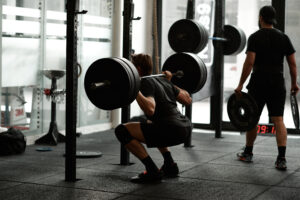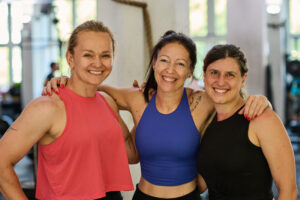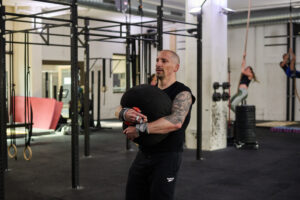
In the realm of fitness, we often hear about strength, endurance, and power. But there’s another essential component that often gets overlooked: mobility. Mobility is about more than being flexible—it’s the ability to move a joint through its full range of motion with control and stability. When it comes to training, mobility matters because it directly influences movement efficiency, which is essential not only for athletic performance but also for functional, everyday tasks. In fact, becoming a “better mover” can mean the difference between winning or falling short in both sports and life.
Movement efficiency: the key to effective training
Movement efficiency refers to how well a person can perform movements with minimal wasted energy. In training, movement efficiency allows an athlete to perform exercises with proper technique and reduced risk of injury. This efficiency depends heavily on mobility, as an athlete who can move through exercises with ease will conserve more energy than someone who has to strain to reach the same positions.
Take, for example, a common CrossFit workout: the overhead squat. This exercise requires a combination of hip, shoulder, and ankle mobility. If an athlete has restricted mobility, they’ll struggle to reach the correct squat depth or keep their arms overhead without compromising their back position. Instead of focusing on the weight or repetitions, they’ll use energy just to hold the position—resulting in fatigue, less power, and a greater risk of injury. On the other hand, an athlete with good mobility can focus on driving up powerfully from the squat position, using their energy efficiently to lift more weight or complete more reps.
Mobility in action: who wins the workout?
Imagine two athletes: both are equally strong, both have similar endurance, and both have a comparable level of fitness. The difference? One has excellent mobility, while the other has a limited one. Let’s put them through a high-intensity workout that includes movements like overhead squats, pull-ups, and kettlebell swings. How will their different levels of the ability to reach the end range in ease impact their performance?
1. Reaching end positions: The athlete with better mobility can reach the full range of each movement without compromising their form. When they squat, they can reach the proper depth and keep their heels on the ground, allowing for a smooth, controlled movement. In contrast, the athlete with limited mobility might struggle to reach these end positions, and even if they manage to do so, it’ll require more energy to hold the form.
2. Speed and efficiency: The athlete with greater mobility can move faster because they don’t need to work as hard to get into position. Every movement flows seamlessly from one to the next, conserving energy for the workout’s duration. The athlete with limited ability to reach the end range , however, will tire faster because each movement requires more effort, making them slower over time. In a high-intensity environment, this makes a significant difference.
3. Risk of injury: The athlete with restricted mobility risks injury. If they attempt to force a squat beyond their current range, for instance, they might strain their knees or back. The better-mover can complete the workout safely, without placing undue stress on their joints or muscles.
So, who wins the workout? It’s the athlete with mobility. They can reach each end position with ease, use less energy to get there, and move faster without risking injury.
Mobility beyond the gym: life’s daily “workouts”
Mobility isn’t just crucial for sports or training; it’s a foundational component for functional, daily movement. From reaching high shelves to bending down to pick something up, mobility affects our daily lives. A mobile body enables you to perform these tasks without strain or discomfort, just as it allows you to move efficiently through exercises in the gym.
Consider the example of two individuals, both fit and healthy, who bend down to pick up a heavy object. The individual with better mobility can maintain a strong, stable position, using their hips and legs to lift the object safely and efficiently. The other, less mobile individual might have to compensate by rounding their back or shifting their weight awkwardly, increasing their risk of injury. In the long run, a mobile body endures fewer wear-and-tear injuries, leading to a higher quality of life and a longer health span.
How to improve your mobility
Improving mobility doesn’t require drastic changes to your workout routine, but it does require consistent, focused effort. Here are a few methods to incorporate mobility work into your daily fitness routine:
1. Dynamic warm-ups: Start each workout with dynamic movements that activate and loosen your muscles. Leg swings, arm circles, and lunges are great options that help prepare your joints for movement.
2. Static stretching post-workout: While static stretching isn’t ideal before a workout, it’s beneficial afterward when your muscles are warm. Stretching the hamstrings, shoulders, hips, and back can improve flexibility and prevent stiffness.
3. Dedicated mobility sessions: Incorporate mobility-specific exercises, such as hip openers, ankle stretches, and thoracic spine rotations, a few times a week. Many find that a yoga class or foam rolling session complements their training.
4. Focus on breathing: Often, limited mobility stems from tension and tightness. Practicing deep, diaphragmatic breathing while stretching helps your body relax and increases your range of motion.
5. Joint circles and controlled movements: Moving each joint through its full range daily—neck, shoulders, wrists, hips, knees, and ankles—can prevent stiffness and increase control over these end positions.
Mobility at CrossFit Kreis 9
At CrossFit Kreis 9, we recognize that mobility is essential for developing a strong, resilient body, and we have multiple ways to support our members in this area. Mobility drills are integrated into every warm-up, helping you prepare for each workout with optimal movement quality and reduced injury risk. For those wanting to dive deeper, we offer a dedicated Mobility Class every Sunday evening, a perfect way to end your week by enhancing flexibility, joint health, and range of motion. Additionally, we provide a Functional Movement Screen (FMS) to assess movement limitations and imbalances. Based on the FMS results, our coaches can guide you through corrective exercises tailored to your needs, so you can build a solid foundation of functional movement. Whether you’re targeting performance gains or simply aiming for better movement in daily life, our approach to mobility will set you up for lasting success.
Final thoughts
Strength and endurance are critical aspects of fitness, but mobility is the bridge that connects them. The better mover—the one who can achieve and control full range of motion—ultimately has the advantage. This advantage isn’t only valuable in the gym but extends to everyday activities, enhancing quality of life and reducing the risk of injury.
Investing time in mobility may seem like a slow process compared to building strength or endurance, but it’s essential for optimizing overall movement efficiency. The athlete or individual with mobility on their side can perform every movement with greater ease, speed, and control, which ultimately allows them to excel in training, sports, and daily life. So, the next time you’re tempted to skip that mobility session, remember: the better mover wins. And with our Sunday Mobility class and tools such as the Functional Movement Screen at CrossFit Kreis 9, that could be you.
- Dale
About the author:

Meet Dale, an experienced personal trainer and coach who approaches fitness holistically. With a CrossFit Level 2 Trainer certification and extensive credentials in functional movement screening, functional training, and football coaching, Dale brings a diverse skill set to his coaching. As a former professional football player and IFBB coach, he understands the importance of balance and tailored training methods. Get ready to embark on a comprehensive fitness journey with Dale, where every aspect of your well-being is prioritized.




